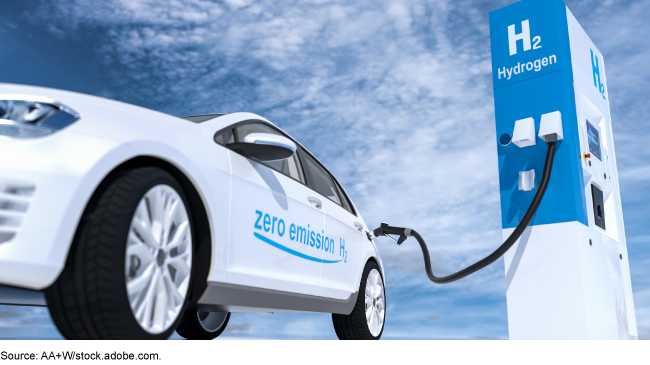Science & Tech Spotlight: Hydrogen Uses
Fast Facts
Depending on how it is produced, hydrogen could play a significant role in reducing greenhouse gases and pollution. This Spotlight examines some potential benefits and challenges to expanding its use.
For example, hydrogen-powered cars are being built, but there aren't many places to refuel, and it can be expensive. Hydrogen can be mixed with natural gas to generate electricity, but it burns hot and may overheat conventional equipment.
The federal government provides support for research and development that may help address these challenges. A 2021 law authorized up to $8 billion to help bring clean hydrogen to the market faster.

Highlights
Why This Matters
Hydrogen has potential uses in many industries, including steel production, vehicle fuel cells, aviation fuel, and power generation. If produced with low-carbon methods, it could play a significant role in reducing greenhouse gas emissions and air pollution. However, there is disagreement about the viability of hydrogen as an energy solution in some uses.
Key Takeaways
- Hydrogen uses vary in maturity. For example, hydrogen-fueled vehicles are available in a few markets, while hydrogen’s use in long-range aircraft is not mature.
- Obstacles to using hydrogen more widely include high costs and the need to significantly modify infrastructure for many applications.
- Additional research and development (R&D) may help address these challenges, and hydrogen “hubs” have been funded to accelerate commercialization.
The Technology
What is it? Hydrogen is a versatile fuel and a useful ingredient in certain industries. Its use produces no carbon dioxide, making it potentially useful for decarbonization in some applications. Today, hydrogen is mostly used in certain mature industrial processes, including production of ammonia for fertilizer and removal of sulfur in oil refining. Hydrogen has many potential uses, such as:
- Steel production. Hydrogen can replace coke (used to remove oxygen) or natural gas in the production of iron and steel. It has been successfully used in some pilot programs but has not been used at scale in this application. This is due to the cost of hydrogen and the need to design new plants or retrofit existing plants.
- Vehicle fuel cells. Several manufacturers have begun making cars powered by hydrogen fuel cells, which are primarily available in California because of its tailpipe emissions standards. Refueling infrastructure is limited, with around 60 stations in California as of 2024. Hydrogen fuel is also costly. It can cost around $200 to refuel a car (with a range of about 400 miles). Hydrogen fuel cells may be more advantageous for decarbonizing heavy-duty trucks. Once commercially available, these vehicles might weigh less and have a longer range than electric trucks.

Figure 1. Examples of Potential Changes to Facilitate Hydrogen Use
- Aviation fuels. Some companies have conducted successful test flights of small, short-range aircraft using hydrogen fuel cells and are aiming for commercial operations in 2025. Larger and longer-range aircraft are more likely to use liquid hydrogen as it is more efficient than fuel cells but is a less mature technology, requiring new propulsion systems, new onboard fuel storage systems, and changes to the fuel supply chain.
- Power generation and heating. Hydrogen can be used to generate electricity or heat. In industrial heating, hydrogen could help decarbonize certain processes that require high temperatures, such as steel, glass, and cement production. However, because hydrogen burns hotter than natural gas, using it could require new burner designs or retrofits for existing equipment. Neither option is commercially available. And burning hydrogen can result in emissions of unhealthy nitrogen oxides.
Opportunities
- Decarbonization. Today, hydrogen is mostly produced using fossil fuels because it is the least costly method. Hydrogen can also be produced using renewable energy. It is defined as “clean” hydrogen if production generates 2 kilograms of carbon dioxide or less per kilogram of hydrogen. (Fossil-based production, without carbon capture, generates about 9-20 kilograms.)
- Research and development. While the processes used to produce hydrogen are mature, further R&D is needed to improve efficiency and reduce costs.
- Hydrogen hubs. The federal government supports clean hydrogen through R&D, grants, loans, and tax credit programs. For example, the Infrastructure Investment and Jobs Act authorized up to $8 billion to establish regional clean hydrogen hubs and promote commercialization. The aim is to create networks of clean hydrogen producers, consumers, and infrastructure in close proximity that could accelerate large-scale production and use. In 2023, the Department of Energy (DOE) selected seven hubs for award negotiation.
Challenges
Challenges specific to each hydrogen use vary (see “The Technology”). The following may impede further adoption:
- Cost. Methods for producing, transporting, and storing hydrogen are generally mature but expensive. Excluding subsidies, the cost of clean hydrogen may be 2 to 4 times that of fossil-based hydrogen. DOE projects costs may decline 50 percent by 2030.
- Competing technologies. While hydrogen could be used in many applications, it may not always be the best technology choice because of high costs, availability of alternatives, and a limited hydrogen supply chain.
Policy Context and Questions
- How effective are hydrogen hubs in promoting use and commercialization?
- What additional efforts, if any, could help reduce costs so that clean hydrogen use is more viable?
- What are the trade-offs of using hydrogen fuel cells versus electric battery vehicles for decarbonizing transportation?
Selected GAO Works
Sustainable Aviation Fuel: Agencies Should Track Progress Toward Ambitious Federal Goals, GAO-23-105300.
Technology Assessment: Decarbonization, GAO-22-105274.
Selected References
Department of Energy, “Pathways to Commercial Liftoff: Clean Hydrogen”, March 2023.
For more information, contact Brian Bothwell at (202) 512-6888 or bothwellb@gao.gov.
